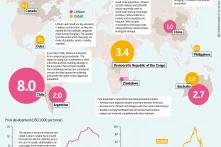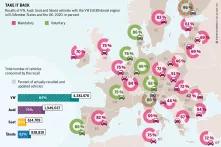
The European Commission's Fit-for-55 package proposal to go to 100% zero emission car sales from 2035 shows a serious commitment for reaching carbon neutrality by 2050, and will put European industry in the driving seat to dominate the new global electric vehicle (EV) market. While this move could democratise the purchase of EVs, policy-makers need to take a small extra step to ensure early build up of EVs to drive cost reductions and fully guarantee that chargers are available in the right locations.

This article is part of our dossier "The EU's Fit-for-55 package: The European Green Deal's fitness test".
On 14 July 2021, the European Commission finally adopted one of the most important packages of climate legislation the world has ever seen. The ‘Fit for 55’ package revises the EU’s main climate and energy legislation and is intended to put the EU on track to cut overall greenhouse gas (GHG) emissions by at least 55% by 2030 and reach net zero emissions by 2050.
Road transport is amongst the big polluters, with cars alone responsible for 12% of all GHG emissions in Europe. Switching from polluting engines to fully electric is a crucial step to reaching net-zero emissions by mid-century. Turning this objective into reality means setting significantly higher CO2 reduction targets for new cars and vans, with the last engine car - be it gas, diesel or hybrid - sold no later than 2035. As the Intergovernmental Panel on Climate Change’s (IPCC) recent and damning report has made abundantly clear, there is no time to waste.
Last year, the entry into force of the EU’s 2020/21 car CO2 standard of 95g CO2/km (to be met by each carmaker on average over their entire new vehicle fleet) saw emissions of new cars decrease by 12% - an unprecedented drop. Over the last 18 months, these targets have sent electric car sales soaring - reaching 16% of new car sales EU-wide in the first half of 2021 - allowing many Europeans to buy their first electric vehicle (EV) and making the EU the biggest EV market globally.
EVs have zero tailpipe emissions, but are also by far the best option for the environment when taking into account lifecycle CO2 emissions. Transpoert & Environment (T&E) has shown that, already today, an average EU electric car is already close to three times better than an equivalent conventional car - a ratio that will progressively improve for EVs as the electricity grid and economy continue to decarbonise.
On top of ambitious car CO2 standards, more action to reduce the emissions from the wider fleet is also needed, notably curbing the use of conventional cars currently in operation (via city ICE bans for example) and avoiding unnecessary private car journeys.
Phasing out engine cars
With the review of the car CO2 standards a central part of the ‘Fit for 55’ package, voices in the European Commission had been hinting for a while that an end date for the sale of engine cars would be in the final car CO2 targets proposal. The big question was whether the European Commission would hold its nerve against pressure from carmakers and certain governments to give polluting petrol and diesel cars a new lease of life.
On this point, the final proposal to go to 100% zero-emission car sales from 2035 shows the European Commission is serious about reaching carbon neutrality by 2050, and will put European industry in the driving seat to dominate the new global EV market. It will also democratise electric vehicles in Europe, ensuring they become affordable and accessible to all Europeans from Porto to Poznań.
Produced in small numbers - just enough to allow carmakers to meet EU mandated CO2 targets - electric cars are still expensive. Carmakers need to move to mass production to drive costs down, just as Henry Ford did with petrol cars at the beginning of the last century. T&E's analysis shows that if we continue to ramp up electric car volumes, they will be cheaper to buy than petrol in just six years’ time.
The trajectory and pace of the ramp up to reach 100% zero emission cars also matters, however. The revised 2030 CO2 target - up from 37.5% to 55% - means half of cars sold across the EU by the end of this decade will be battery electric (less if some are hybrids). This is considerably less than the two-thirds battery electric sales that the EU needs to be on a cost-effective path to full electric by 2035.
Regrettably, the European Commission only proposed an increase of the 2030 CO2 target. Leaving the weak 2025 target of just 15% untouched means little progress in the next 8-9 years. This risks EV production stagnating, delaying the point at which they become affordable to the mass market. With cars one of the single largest sources of CO2 emissions, this will seriously undermine Europe’s aim to be ‘fit for 55’ by 2030.
Beyond the headline CO2 targets, it is important to highlight several weaknesses and risks in the design of the proposed regulation. Firstly, the rise of plug-in hybrid vehicles (PHEVs). Despite strong overall EV sales in Europe, a growing proportion (up to 59% in the first half of this year) is made up of PHEVs. As T&E showed in a report last year, PHEVs are basically ‘fake electrics’ - emitting between 4-8 times more CO2 on the road than their official test results actually state (see also ICCT on this) - and used by carmakers as a compliance trick to meet their CO2 targets. If more realistic CO2 emissions were used, it would be much harder for carmakers to comply with the CO2 standards and would have to make and sell more pure battery electric cars.
One of the reasons for the recent rise of PHEVs is the way they are credited under the so-called ZLEV (zero- and low-emission vehicle) benchmark, which allows carmakers selling more than 15% ZLEVs to benefit from a relaxation of their CO2 target by up to 5%. PHEVs are currently counted towards this benchmark using a multiplier of 0.7, which artificially reduces their CO2 emissions by 30%. Policy makers should ensure the revised regulation stops inflating the climate contribution of these fake electrics and end credits to PHEVs, by turning the ZLEV benchmark into a ZEV benchmark.
The European Commission’s proposal has also left untouched a number of other flexibilities for carmakers from the current regulation that will undermine ambition via the backdoor. Using the 2025 target as an example, T&E has shown that as little as a 2% (vs. 15%) CO2 cut can actually be required of carmakers between 2025 and 2029. This is due to flexibilities including an allowance for carmakers selling heavier premium cars (the CO2 mass adjustment) - a provision neither justifiable on climate, social justice, nor technological grounds and one of the principal reasons for the surging sales of heavy and highly-polluting SUVs across Europe in recent years.
Alternative Fuels Infrastructure Regulation (AFIR)
Finally a word on charging. As part of the ‘Fit for 55’ package, the European Commission also presented a completely revamped vehicle infrastructure law to make charging anxiety a thing of the past. As part of the revised Alternative Fuels Infrastructure Regulation (AFIR), EU countries will be mandated to deploy enough public chargers to match the fast-rising sales of electric cars. This is a huge improvement on the current outdated version of the law from 2014, and means that there will be a comprehensive public charging network from 2025 for electric cars, vans and trucks to drive seamlessly across Europe.
Unfortunately, though, EV drivers will have to wait until 2030 to have the full road network covered. In urban areas, electric car drivers that need to top up, or that don’t have a private charger, have no guarantees under the current proposal that they will find fast charging hubs or chargers at their local supermarket or other stores.
The 2020s is the critical decade which will democratise EVs and it is incumbent on MEPs and national governments - now responsible for amending the European Commission’s proposals - to ensure the regulatory framework is fit for purpose to accelerate the transition. Although the framework of the new AFIR law is adequate, policy-makers need to take a small extra step to fully guarantee that chargers are available in the right locations, and people can use their car for all their needs. Car CO2 targets must be increased too for 2025 and 2030 (including an interim 2027 target) in line with the cost-effective trajectory so that sales of battery electric vehicles hit 22% in 2025, 37% in 2027 and 67% in 2030. We have a golden opportunity to make this Europe's Henry Ford moment (this time for EVs). However, this is not guaranteed unless we are more ambitious on CO2 standards. As the climate crisis accelerates around us, it is incumbent on policy-makers to accelerate the transition to affordable zero emission transport now.


